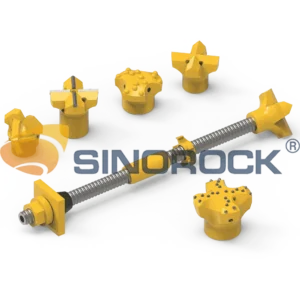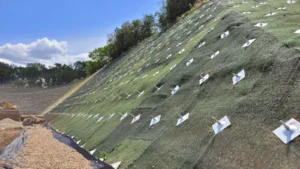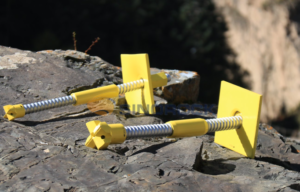Introduction
Slope stabilization has long been a crucial area of focus in geotechnical engineering, particularly in regions prone to erosion, landslides, and unstable ground conditions. Slope failures can result in catastrophic consequences, including loss of life, damage to infrastructure, and environmental degradation. As a result, the development and refinement of stabilization methods are paramount in modern construction and civil engineering projects.
One traditional method of slope stabilization involves the use of flexible steel mesh facing, particularly in North America. In this method, the mesh is anchored at the top of the slope and allowed to cascade down, using the material’s weight and friction to maintain stability. However, these conventional methods face significant limitations, particularly with the tensile strength of standard wire mesh, making it challenging to ensure long-term stability in more demanding conditions.
This has spurred the development of innovative solutions, such as high-tensile strength steel bar wire mesh and advanced self-drilling anchor system technology. These systems offer enhanced performance, longevity, and adaptability for a wide range of geotechnical applications, including temporary shoring during construction. In this article, we will explore the advancements in soil nailing and anchoring, with a particular focus on their application in temporary shoring, examining how they have revolutionized slope stabilization in modern engineering.
Historical Context of Slope Stabilization
Historically, slope stabilization relied heavily on anchoring systems located at the top of slopes. This approach was widely used in North America and was effective for moderate slopes or areas with less susceptibility to landslides. However, the limitations of traditional methods became apparent as geotechnical projects expanded into more challenging environments, such as mountainous regions, areas prone to severe weather, or construction sites with complex soil compositions.
One of the key issues with these traditional methods was the reliance on conventional wire mesh, which had a relatively low tensile strength. Over time, the mesh would often degrade, corrode, or deform under heavy loads, compromising its ability to provide adequate slope stabilization. Additionally, in regions with high rainfall or seismic activity, the lack of adaptability of traditional wire mesh systems led to frequent slope failures.
As a result, geotechnical engineers began exploring alternatives, leading to the development of advanced materials and techniques designed to overcome the inherent weaknesses of older systems. These advances have transformed slope stabilization, offering more robust solutions that are better suited to the demands of modern infrastructure projects.
Steel Bar Wire Mesh: A Technological Breakthrough
The breakthrough in slope stabilization came with the introduction of steel bar wire mesh. Made from high-tensile steel and treated with corrosion-resistant coatings, this material has overcome the limitations of conventional wire mesh. The transition from wire rope nets to steel bar wire mesh represents a significant leap forward, not only in terms of strength but also in affordability, making this technology accessible for a wide range of applications.
The steel bar wire mesh offers several advantages over traditional materials:
- High tensile strength: Capable of withstanding greater loads, reducing the risk of failure in high-stress conditions.
- Corrosion resistance: Ensures durability in environments prone to moisture and other corrosive elements, extending the lifespan of the stabilization system.
- Cost-effectiveness: Achieves performance levels comparable to, or better than, wire rope nets but at a significantly lower cost, making it suitable for large-scale projects.
Extensive testing has confirmed the superior performance of steel bar wire mesh, demonstrating its ability to meet or exceed the requirements of modern slope stabilization projects. Its high tensile strength allows it to bear the weight of slopes prone to sliding or erosion, while its corrosion resistance ensures that it will endure harsh environmental conditions over extended periods.
This innovative material is rapidly gaining acceptance in the industry due to its balance between strength, durability, and cost-effectiveness. It has become a reliable solution for engineers seeking to stabilize slopes in both temporary and permanent applications.
Self-drilling Anchor System Technology
An essential aspect of slope stabilization is the effective transfer of forces from the facing material to the anchoring system. Traditional slope stabilization methods often involved inefficient force transfer mechanisms, which led to areas of instability, especially in weak soils or erodible surfaces. The introduction of self-drilling anchor system technology has significantly improved force transfer, providing enhanced stability even in challenging geotechnical conditions.

The self-drilling anchor system integrates drilling, grouting, and anchoring into one efficient process, allowing for quicker and more reliable installation. These anchors are designed to drill through unstable soil or fractured rock without the need for a casing, making them ideal for slopes requiring stabilization.
Key benefits of self-drilling anchor system technology include:
- Enhanced force distribution: The self-drilling anchor system ensures that forces are evenly transferred from the mesh to the anchor, preventing stress concentrations that could lead to localized slope deformations.
- Drilling through unstable ground: The system is specifically designed to penetrate unstable soil or fractured rock, making it highly effective for use in weak or loose ground conditions.
- Simultaneous drilling and grouting: By combining the drilling and grouting processes into one, the system ensures a secure bond between the anchor and the surrounding ground, improving overall stability and reducing installation time.
- Corrosion resistance: Self-drilling anchors can be treated with corrosion-resistant coatings, ensuring long-term durability even in harsh environmental conditions.
By combining the high strength of steel bar wire mesh with the advanced functionality of the self-drilling anchor system, engineers can design slope stabilization systems that are robust, reliable, and adaptable to a wide range of geotechnical conditions. This system provides increased stability in areas prone to landslides or erosion, offering a long-term, durable solution for slope stabilization projects.
Dimensioning Models and Anchor Design
The integration of steel bar wire mesh and self-drilling anchor system technology has led to the development of sophisticated dimensioning models for slope stabilization systems. These models take into account various critical factors, such as:
- Slope geometry: Including slope angle, height, and overall topography.
- Soil composition: Understanding the type of soil present (e.g., clay, silt, sand) and its potential for erosion or failure.
- Environmental conditions: Wind, rain, temperature variations, and other external factors that can influence the stability of the slope.
By utilizing these dimensioning models, engineers can design customized stabilization solutions that are optimized for the unique challenges presented by each site. This level of precision ensures that the stabilization system is capable of withstanding the anticipated loads and environmental stresses, resulting in a more reliable and long-lasting solution.
In addition, anchor design plays a crucial role in the overall performance of the stabilization system. Anchors must be dimensioned and positioned according to the specific needs of the slope, ensuring that they provide adequate support and force transfer to the steel barwire mesh. By integrating advanced dimensioning models, geotechnical engineers can create anchors that are perfectly suited to the conditions of the slope, maximizing the stability and effectiveness of the system.
An essential aspect of slope stabilization is the effective transfer of forces from the facing material to the anchoring system. Traditional slope stabilization methods often involved inefficient force transfer mechanisms, which led to areas of instability, especially in weak soils or erodible surfaces. The introduction of self-drilling anchor system technology has significantly improved force transfer, providing enhanced stability even in challenging geotechnical conditions.
The self-drilling anchor system integrates drilling, grouting, and anchoring into one efficient process, allowing for quicker and more reliable installation. These anchors are designed to drill through unstable soil or fractured rock without the need for a casing, making them ideal for slopes requiring stabilization.
Key benefits of self-drilling anchor system technology include:
- Enhanced force distribution: The self-drilling anchor system ensures that forces are evenly transferred from the mesh to the anchor, preventing stress concentrations that could lead to localized slope deformations.
- Drilling through unstable ground: The system is specifically designed to penetrate unstable soil or fractured rock, making it highly effective for use in weak or loose ground conditions.
- Simultaneous drilling and grouting: By combining the drilling and grouting process into one, the system ensures a secure bond between the anchor and the surrounding ground, improving overall stability and reducing installation time.
- Corrosion resistance: Self-drilling anchors can be treated with corrosion-resistant coatings, ensuring long-term durability even in harsh environmental conditions.
By combining the high strength of steel bar wire mesh with the advanced functionality of the self-drilling anchor system, engineers can design slope stabilization systems that are robust, reliable, and adaptable to a wide range of geotechnical conditions. This system provides increased stability in areas prone to landslides or erosion, offering a long-term, durable solution for slope stabilization projects.
Dimensioning Models and Anchor Design
The integration of steel bar wire mesh and self-drilling anchor system technology has led to the development of sophisticated dimensioning models for slope stabilization systems. These models take into account various critical factors, such as:
- Slope geometry: Including slope angle, height, and overall topography.
- Soil composition: Understanding the type of soil present (e.g., clay, silt, sand) and its potential for erosion or failure.
- Environmental conditions: Wind, rain, temperature variations, and other external factors that can influence the stability of the slope.
By utilizing these dimensioning models, engineers can design customized stabilization solutions that are optimized for the unique challenges presented by each site. This level of precision ensures that the stabilization system is capable of withstanding the anticipated loads and environmental stresses, resulting in a more reliable and long-lasting solution.
In addition, anchor design plays a crucial role in the overall performance of the stabilization system. Anchors must be dimensioned and positioned according to the specific needs of the slope, ensuring that they provide adequate support and force transfer to the steel bar wire mesh. By integrating advanced dimensioning models, geotechnical engineers can create anchors that are perfectly suited to the conditions of the slope, maximizing the stability and effectiveness of the system.
Temporary Shoring Application: Expanding the Utility of Soil Nailing and Anchoring
While diagonal wire mesh and anchor plate systems were initially developed for permanent slope stabilization, their adaptability has made them equally valuable for temporary shoring applications. Temporary shoring is often required during construction projects to provide short-term stability to excavations, slopes, or other structures. In these cases, the need for a cost-effective and reliable solution is paramount.
The ability to pre-tension diagonal wire mesh against a slope makes it particularly well-suited for temporary shoring applications. By applying tension to the mesh, engineers can create a stable surface that resists movement and prevents soil from collapsing during construction. This is especially useful in situations where the ground must be excavated to create deep foundations, as it minimizes the risk of cave-ins or other failures.
Additionally, the ease of installation and adaptability of diagonal wire mesh and anchor plates means that they can be quickly deployed in emergency situations, such as landslides or erosion caused by extreme weather events. In these cases, temporary shoring may be required to protect critical infrastructure or prevent further damage to the surrounding environment. The versatility of these systems makes them ideal for both planned construction projects and rapid response scenarios.
Conclusion
The field of slope stabilization has undergone significant advancements with the introduction of diagonal wire mesh and anchor plate technology. These innovations have addressed many of the limitations of traditional methods, offering geotechnical engineers more robust, cost-effective, and versatile solutions for both permanent slope stabilization and temporary shoring applications.
The ability to pre-tension the mesh, combined with advanced dimensioning models and precise anchor design, ensures that these systems can provide reliable support in a wide range of environmental conditions. As more engineers and construction professionals adopt these technologies, their use is likely to expand further, transforming how slope stabilization is approached in the industry.
By integrating these innovations into temporary shoring applications, geotechnical professionals have a valuable tool that enhances safety, stability, and efficiency on construction sites around the world. The future of soil nailing and anchoring in geotechnical engineering looks bright, with these advancements paving the way for more resilient and adaptable solutions.





